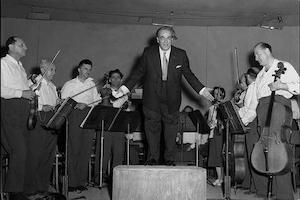Music Library
Feature Fridays Heitor Villa-Lobos

For National Hispanic Heritage Month, Music Library Assistant Ryan Jacobs has chosen three Latin American composers to highlight from the Naxos Music Library. This is part two of a three- part series. These individuals were chosen as some of the premier examples of composers whose work has been shaped heavily by the culture and influence of their native lands and lands where they traveled.
Heitor Villa-Lobos
The second composer I wish to highlight in this series is Heitor Villa-Lobos, the foremost Brazilian composer of the 20th century. He traveled extensively throughout Brazil in the formative period of his career, and his works put Brazil on the wider cultural map of classical music. He was later given charge of the country’s music education after the government was overthrown. He chose to structure the resulting institutions with a particular emphasis on Brazilian folk and popular influences.
I want to first dive into his Bachianas brasileiras (specifically No. 9), which are a series of many pieces with wildly varying ensembles from chamber to full orchestra. They represent an entanglement of Baroque techniques and Brazilian folk idioms.
From his adolescence, Villa-Lobos had been fascinated by Bach, finding in his work analogies with the traditional music of Brazil. Thus the present sequence was intended as an explicit homage to Bach, a factor most evident in the designation of almost every movement with twin titles alluding both to the actual movements of Baroque suite forms and also to specific Brazilian popular styles.
Bachianas brasileiras No. 9, composed in New York during 1945, is in many respects a summation of the whole series. Originally written for an unaccompanied chorus, it sounds equally convincing when played by string orchestra, and might be thought of as a musical paradigm for the synthesis that Villa-Lobos had sought in the previous eight works. Thus the Prelúdio is taken up with a long-breathed melody, unfolding in expansive harmonies that could almost be a composite of those already heard. Only when the Fuga proceeds is the theme revealed as the subject of the latter movement which ranks among the most impressive of the composer’s such pieces. Although the range of contrapuntal techniques is applied, the most striking factor is the composer’s blurring of the distinction between what is Bachian and what is Brazilian, surely an intentional QED as the work, and the series as a whole, reaches its affirmative close. (Naxos)
Another example of cultural influence in the music of Villa-Lobos is in his chôros series, the title of which is a reference to Brazilian street musicians who use a combination of European and African instrumentation. Villa-Lobos viewed the chôros series as an extension of this music.
Chôros No. 10 is widely considered to be a distilled representation of the larger series, telling the story of the untouched beauty of the Amazon and the arrival of humankind. “The work’s opening imparts impressions of Brazil’s sonorous natural riches with indigenous melodies and birdsongs, providing an extended prelude to the choral section. The mixed chorus functions at the same level of value and distinction as that of the orchestral architecture, singing vocables meant to evoke aboriginal languages. (Béhague, Heitor Villa-Lobos: The search for Brazil’s musical soul, pp.87-96)
The final piece from Villa-Lobos that I wish to highlight is the ballet Uirapuru, which originated as a symphonic poem, featuring birdsong as a major compositional theme. “Uirapuru” is a term used to describe various bird families in Brazil with particularly tuneful and melodious songs.
Uirapuru is the offspring of international modernism. Villa-Lobos not only displays his constant interest in the richness of texture, tonal expansion, orchestral color, fluidity of form, melodic symmetry, and the rereading of his compositional references (particularly Wagner, Debussy, and Stravinsky), but creates a specifically Brazilian sound, without directly drawing on folkloric elements—precisely what makes him one of the supreme inventors of Brazilian culture.
In the ballet's storyline, indigenous groups find themselves drawn deep into the forest by the magic of the bird's song; there, a young woman hunts the uirapuru and sees it transform into a young male warrior. Finally, when he is killed by an indigenous intruder, he transforms once again into a bird. The story and the music create a very distant echo of Debussy's Prélude à l'après-midi d'un faune and Stravinsky's Firebird. Villa-Lobos, without the interest in real bird song that Messiaen had, transforms the theme of the uirapuru into a model of stylized symmetry, which opens up into a complex network of formal and harmonic growth. Especially after being recorded by Leopold Stokowski, Uirapuru deservedly became a calling card for the modernist Villa-Lobos. (Naxos)
In addition to the three composers highlighted in this series, there are many other hispanic and latinx composers’ works available to listen to via Naxos. We have prepared a playlist including some of this great music! This list is by no means exhaustive, as there are a myriad of high-quality recordings of incredible works of music by hispanic composers available through Naxos, and further research and listening (either independently or with the assistance of the Music Library) is highly recommended.
